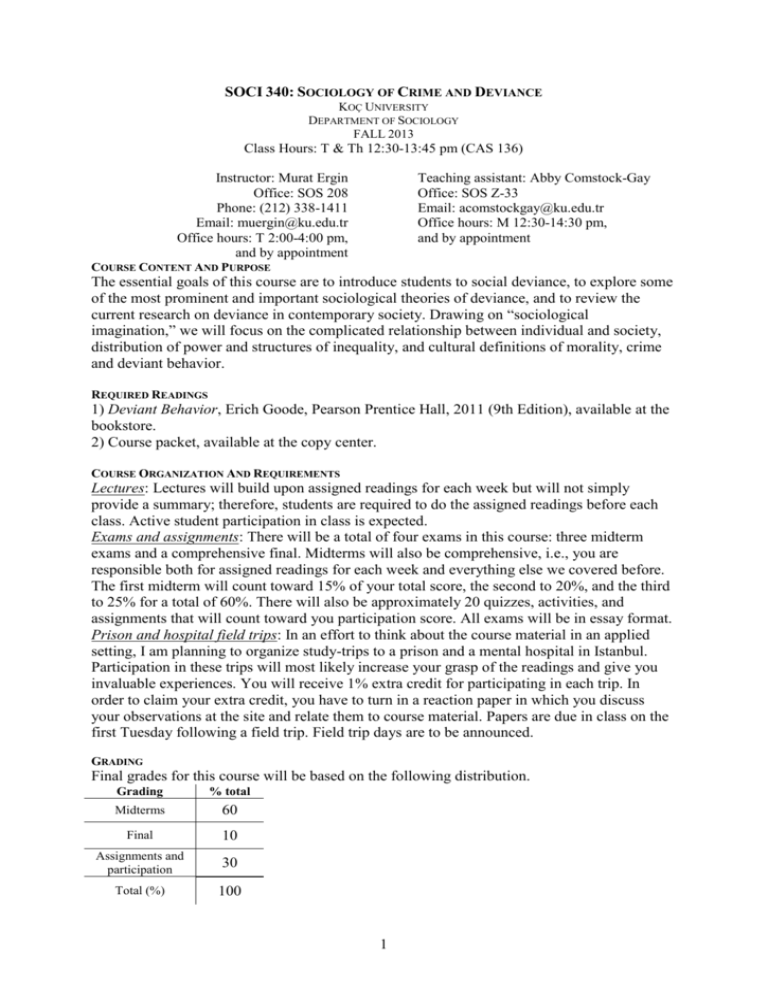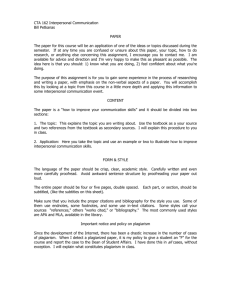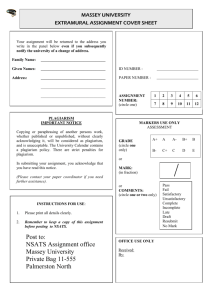
SOCI 340: SOCIOLOGY OF CRIME AND DEVIANCE
KOÇ UNIVERSITY
DEPARTMENT OF SOCIOLOGY
FALL 2013
Class Hours: T & Th 12:30-13:45 pm (CAS 136)
Instructor: Murat Ergin
Office: SOS 208
Phone: (212) 338-1411
Email: muergin@ku.edu.tr
Office hours: T 2:00-4:00 pm,
and by appointment
Teaching assistant: Abby Comstock-Gay
Office: SOS Z-33
Email: acomstockgay@ku.edu.tr
Office hours: M 12:30-14:30 pm,
and by appointment
COURSE CONTENT AND PURPOSE
The essential goals of this course are to introduce students to social deviance, to explore some
of the most prominent and important sociological theories of deviance, and to review the
current research on deviance in contemporary society. Drawing on “sociological
imagination,” we will focus on the complicated relationship between individual and society,
distribution of power and structures of inequality, and cultural definitions of morality, crime
and deviant behavior.
REQUIRED READINGS
1) Deviant Behavior, Erich Goode, Pearson Prentice Hall, 2011 (9th Edition), available at the
bookstore.
2) Course packet, available at the copy center.
COURSE ORGANIZATION AND REQUIREMENTS
Lectures: Lectures will build upon assigned readings for each week but will not simply
provide a summary; therefore, students are required to do the assigned readings before each
class. Active student participation in class is expected.
Exams and assignments: There will be a total of four exams in this course: three midterm
exams and a comprehensive final. Midterms will also be comprehensive, i.e., you are
responsible both for assigned readings for each week and everything else we covered before.
The first midterm will count toward 15% of your total score, the second to 20%, and the third
to 25% for a total of 60%. There will also be approximately 20 quizzes, activities, and
assignments that will count toward you participation score. All exams will be in essay format.
Prison and hospital field trips: In an effort to think about the course material in an applied
setting, I am planning to organize study-trips to a prison and a mental hospital in Istanbul.
Participation in these trips will most likely increase your grasp of the readings and give you
invaluable experiences. You will receive 1% extra credit for participating in each trip. In
order to claim your extra credit, you have to turn in a reaction paper in which you discuss
your observations at the site and relate them to course material. Papers are due in class on the
first Tuesday following a field trip. Field trip days are to be announced.
GRADING
Final grades for this course will be based on the following distribution.
Grading
% total
Midterms
60
Final
10
Assignments and
participation
30
Total (%)
100
1
Letter grades will be assigned based on the following distribution.
%
Grade
90+
87+
90-
83+
87-
80+
83-
77+
80-
73+
77-
70+
73-
67+
70-
64+
67-
60+
64-
60-
A
A-
B+
B
B-
C+
C
C-
D+
D
F
POLICIES
You can expect me to do my best effort to cover course material in a thought-provoking
manner, abide by the rules and regulations in the syllabus, be available to students when
necessary, and grade exams on time. In return, you need to come to classes on time, remain in
your seat throughout the class period, and avoid talking with other students. Violating
classroom conduct rules will result in reductions in participation points.
The syllabus: This document is a contract between you and me. You are responsible
for all the policies, requirements, and information in this syllabus. By taking this course, you
agree to comply with all course requirements. Note: the instructor can make changes to the
assigned readings, exam dates, etc. under extenuating circumstances. All changes will be
announced in class.
Announcements in class: Announcements in lectures are official and there are no other
official announcements. Students are responsible for all announcements made in classes even
if they are absent on that day. If you happen to miss a lecture, ask other students or me for
announcements you may have missed.
Classroom conduct and being on time: Disruptive behavior has a negative influence on
everyone’s learning. As everyone taking this class has a right to learn in peace and quiet,
disruptive behavior in any form will not be tolerated and will be penalized. Disruptive behavior
includes using cell phones and computers. Do not use your phone, other mobile devices, or
computers in any way during lectures. Students who show up late for classes or leave early also
create considerable disruption and affect everyone’s learning. For this reason, please pay attention
not to disrupt the lecture if you are late. Disruptive students will pay a disruption tax of one
percentage point (to be taken out of their participation score) for each incident.
Attendance: There is no attendance requirement.
Make-up exams: You are allowed to make up missed exams if you have a valid
excuse. If you fail to take an exam, you must meet with me immediately in order to discuss
your situation. If your excuse is validated, you then need to contact Abby to schedule a makeup exam. No early exams will be given in this course.
Extra credit: No extra credit opportunities will be granted to individual students for
any reason.
Academic dishonesty: The following is the university’s official statement on academic
dishonesty.
“Koç University expects all its students to perform course-related activities in accordance with the rules set forth
in the Student Code of Conduct (http://vpaa.ku.edu.tr/academic/student-code-of-conduct). Actions considered as
academic dishonesty at Koç University include but are not limited to cheating, plagiarism, collusion, and
impersonating. This statement’s goal is to draw attention to cheating and plagiarism related actions deemed
unacceptable within the context of Student Code of Conduct:
All individual assignments must be completed by the student himself/herself, and all team assignments
must be completed by the members of the team, without the aid of other individuals. If a team member does not
contribute to the written documents or participate in the activities of the team, his/her name should not appear on
the work submitted for evaluation.
Plagiarism is defined as ‘borrowing or using someone else’s written statements or ideas without giving
written acknowledgement to the author’. Students are encouraged to conduct research beyond the course
material, but they must not use any documents prepared by current or previous students, or notes prepared by
2
instructors at Koç University or other universities without properly citing the source. Furthermore, students are
expected to adhere to the Classroom Code of Conduct (http://vpaa.ku.edu.tr/academic/classroom-code-ofconduct) and to refrain from all forms of unacceptable behavior during lectures. Failure to adhere to expected
behavior may result in disciplinary action.
There are two kinds of plagiarism: Intentional and accidental. Intentional plagiarism (Example: Using a
classmate’s homework as one’s own because the student does not want to spend time working on that
homework) is considered intellectual theft, and there is no need to emphasize the wrongfulness of this act.
Accidental plagiarism, on the other hand, may be considered as a ‘more acceptable’ form of plagiarism by some
students, which is certainly not how it is perceived by the University administration and faculty. The student is
responsible from properly citing a source if he/she is making use of another person’s work. For an example on
accidental plagiarism, please refer to the document titled “An Example on Accidental Plagiarism”.
If you are unsure whether the action you will take would be a violation of Koç University’s Student
Code of Conduct, please consult with your instructor before taking that action.
An Example on Accidental Plagiarism: This example is taken from a document prepared by the City
University of New York.
The following text is taken from Elaine Tyler May’s ‘Myths and Realities of the American Family’:
“Because women's wages often continue to reflect the fiction that men earn the family wage, single mothers
rarely earn enough to support themselves and their children adequately. And because work is still organized
around the assumption that mothers stay home with children, even though few mothers can afford to do so,
child-care facilities in the United States remain woefully inadequate.”
Below, there is an excerpt from a student’s homework, who made use of May’s original text:
“As Elaine Tyler May points out, “women's wages often continue to reflect the fiction that men earn the family
wage” (588). Thus many single mothers cannot support themselves and their children adequately. Furthermore,
since work is based on the assumption that mothers stay home with children, facilities for day care in this
country are still “woefully inadequate.” (May 589)”.
You may think that there is no plagiarism here since the student is citing the original author. However,
this is an instance of accidental plagiarism. Although the student cites May and uses quotation marks
occasionally, the rest of the sentences, more specifically the following section: “Thus many single mothers
cannot support themselves and their children adequately. Furthermore, since work is based on the assumption
that mothers stay home with children, facilities for day care in this country are still “woefully inadequate.” (May
589)” almost exactly duplicates May’s original language. So, in order to avoid plagiarism, the student either had
to use quotation marks for the rest of the sentences as well, or he/she had to paraphrase May’s ideas by using not
only his/her own words, but his/her own original ideas as well. You should keep in mind that accidental
plagiarism often occurs when the student does not really understand the original text but still tries to make use of
it. Understanding the original text and understanding why you agree or disagree with the ideas proposed in that
text is crucial both for avoiding plagiarism and for your intellectual development.
Reference(s):
Avoiding and Detecting Plagiarism: A Guide for Graduate Students and Faculty.
The Graduate Center. City University of New York, 2012. Web.
http://www.gc.cuny.edu/CUNY_GC/media/CUNY-Graduate-Center/PDF/Publications/AvoidingPlagiarism.pdf”
3
CLASS SCHEDULE AND ASSIGNED READINGS
PART I: WHAT IS DEVIANCE?
Week 1: Sep. 17 and 19
Introduction to Deviance
Textbook: Chapter 1
Reader: 1) Becker, Moral Entrepreneurs; 2) Heckert, An Integrated Typology of Deviance
Applied to Ten Middle-Class Norms.
Week 2: Sep. 24 and 26
Approaches to Deviance
Reader: 1) Pfohl, The “Discovery” of Child Abuse.
PART II: THEORIES OF DEVIANCE
Week 3: Oct. 1 and 3
Positivist Theories I
Textbook: Chapter 2
Reader: 1) Merton, Social Structure and Anomie; 2) Becker, Becoming a Marihuana User.
Week 4: Oct. 8 and 10
Positivist Theories II
(Exam 1)
Textbook: Chapter 2
Reader: 1) Sykes and Matza, Techniques of Neutralization; 2) McCabe, The Influence of
Situational Ethics and Cheating Among College Students.
Oct. 14-18: No classes!
Week 5: Oct. 16 and 18
Constructionist Theories
Textbook: Chapter 3
Reader: 1) Liazos, The Poverty of the Sociology of Deviance; 2) Goffman, Stigma and Social
Identity; 3) Lemert, Primary and Secondary Deviation; 4) Goode, On Behalf of Labeling
Theory.
Week 6: Oct. 22 and 24
Foucault
Reader: 1) Downing, Life, Texts, Contexts; 2) Foucault, The Body of the Condemned;
Panopticism; The Carceral.
Week 7: Oct. 31
TBA.
PART III: RESEARCH ON DEVIANCE
Week 8: Nov. 5 and 7
Methods and Criminal Behavior
Textbook: Chapter 4
4
Reader: 1) Laud Humphreys, Tearoom Trade.
Week 9: Nov. 12 and 14
Criminal Violence
(Exam 2)
Textbook: Chapter 5 and 6
Reader: 1) Pontell & Welsh, Incarceration as a Deviant Form of Social Control;
2) Karakus, McGarrell, & Basibuyuk. Fear of Crime Among Citizens of Turkey; 3) Holt,
Decarcarate?
Week 10: Nov. 19 and 21
Illicit Drugs and Alcohol Abuse
Textbook: Chapter 7 and 8
Reader: 1) Gourley, Recreational Ecstasy Users; 2) Reinarman, The Social Construction of
Drug Scares.
Week 11: Nov. 26 and 28
Mental Disorder
Textbook: Chapter 12
Reader: 1) Rosenhan, On Being Sane in Insane Places; 2) Turner and Edgley, From
Witchcraft to Drugcraft; 3) Watters, The Americanization of Mental Illness; 4) Belluck,
Psychiatry;s Guide Is Out of Touch With Science, Experts Say; 5) Friedman, The Book Stops
Here.
Week 12: Dec. 3 and 5
Crimes of the Powerful
Textbook: Chapter 10
Reader: 1) Liederbach, Doctors’ Autonomy and Power; 2) Rothe, War Profiteering: Iraq and
Haliburton.
Week 13: Dec. 10 and 12
Sexual Deviance
(Exam 3)
Textbook: Chapter 9
Reader: 1) Potter, The Cyberporn and Child Sexual Predator Moral Panic; 2) Jenkins, Out of
Control?; 3) Kinnick, Pushing the Envelope.
Week 14: Dec 17 and 19
Cognitive Deviance
Textbook: Chapter 11
Reader: 1) Cross, The Flexibility of Scientific Rhetoric: A Case Study of UFO Researchers;
2) Carey, Journal’s Paper on ESP Expected to Prompt Outrage.
Week 15: Dec. 24 and 26
Physical Characteristics as Deviance
Textbook: Chapter 13
Reader: 1) Degher, The Adoption and Management of a “Fat” Identity; 2) Cahill and
Egglleston, Wheelchair Users.
5






